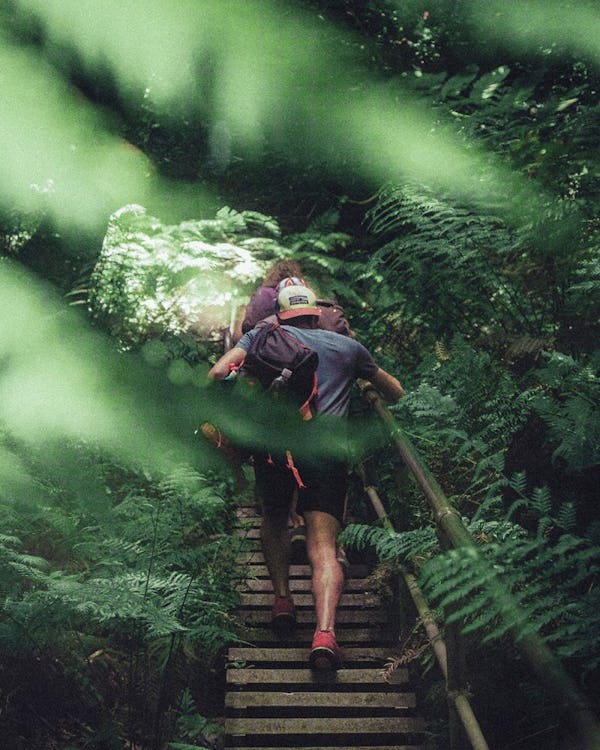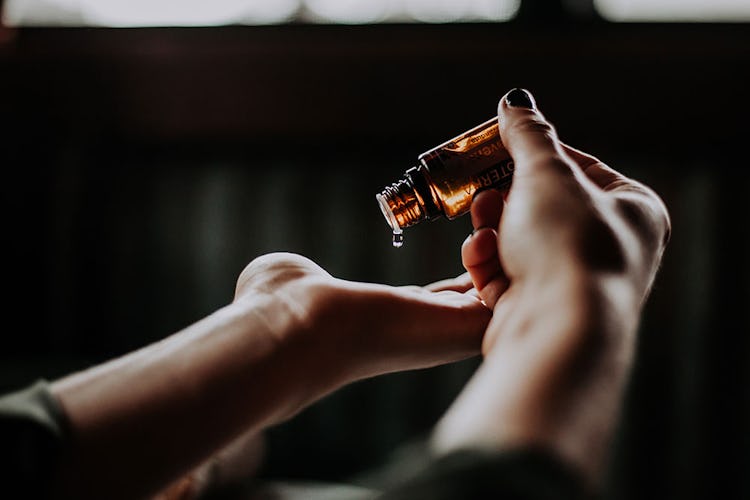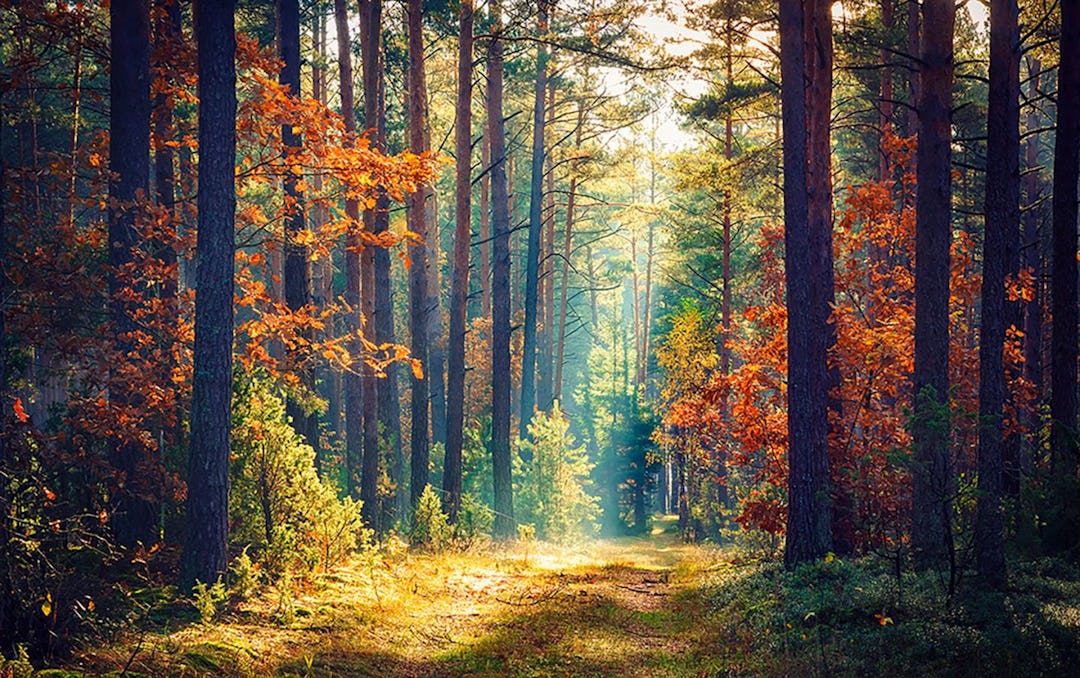“All truly great thoughts are conceived by walking.” – Friedrich Nietzsche
What’s the best thing to do when you’re feeling overwhelmed, angry, or depressed? While booze, drugs, or finding the source of your frustration and breaking its nose might be the first thoughts that spring to mind, you’re more likely to get relief by taking a walk outside accompanied by a few deep breaths.
Forest Bathing: Bust Stress and Boost Your Health by Reconnecting With Nature

Communing with nature is the oldest form of stress management known to humankind, and yet only recently has science begun to really study it. Forest bathing, a Japanese term for bonding with the outdoors for health-boosting purposes, is now being seen as a legitimate form of therapy for tightly-wound people cracking under the pressures of living in the modern world. Even if the nearest jungle to you is a concrete one, there are ways to reap the benefits of being in nature that can add years to your life—or maybe even save it outright.
What Is Forest Bathing?
The expression “forest bathing” comes from a Japanese term coined as recently as the 1980s. “Shinrin-yoku” translates to “forest therapy,” or, “the medicine of being in the forest.”
Of course, appreciating the tranquility of woodsy surroundings dates back much farther than Pac-Man and Flock of Seagulls hairstyles. For as long as people have been living in the cramped conditions of cities, they’ve been looking for reasons to escape them. Nineteenth-century philosopher Friedrich Nietzsche often strolled in nature for more than four hours a day, and he credited the habit with allowing him to conceive his world-changing theories. Nature-loving has been a common trait among other big thinkers too, including psychoanalyst Carl Jung, Albert Einstein, and Aristotle, who taught his students while walking through the wooded hills of ancient Greece.
But it wasn’t until the 80s that famed biologist/naturalist E.O. Wilson started writing about “biophilia”—the concept that humans evolved from nature and so have a deep longing to maintain connection to it. The clamor of urban life, Wilson hypothesized, was getting in the way of us satisfying this primal instinct, and many city dwellers rarely, if ever, spend any substantial length of time in natural settings.
Half a world away from Wilson’s office in Cambridge, Massachusetts, Japanese researchers were coming to similar conclusions, leading to the government making shinrin-yoku part of its national healthcare plan. While two-thirds of the country is covered in trees, the explosive growth of major cities like Tokyo and Kyoto, and widespread rural-to-urban migration, meant that many Japanese people were losing their connection to the agrarian settings their families had thrived in for centuries.
In his aptly titled book, Forest Bathing, Qing Li, a medical doctor at Tokyo’s Nippon Medical School and chairman of the Japanese Society for Forest Medicine, reveals that the Japanese capital is now the world’s most crowded city, with 13.5 million people and 6,158 people per square kilometer (for some perspective, London has 1,500 people per square km, New York 1,800, and Paris 2,844). Not surprisingly, such population density makes it hard for residents to find peace and quiet. The subways are so jam-packed during rush hour that white-gloved oshiya (professional “pushers”) have to shove commuters into over-crowded carriages. And yet, Li writes that he is able to seek solace in the midst of the mayhem by retreating to tree-lined parks to take a daily walk. “This is not exercise, or hiking, or jogging,” he explains. “It is simply being in nature—connecting with it through our sense of sight, hearing, taste, smell, and touch.”

Benefits of Forest Bathing
Philosophically, all people can agree that being active in nature is good for us, but this isn’t merely an assumption anymore. There’s an emerging and growing body of evidence to support the notion, and Dr. Li and his fellow researchers at Nippon Medical School are leading the charge on forest bathing research.
Helps Fight Cancer
NK cells are like the Navy SEALs of the immune system. (NK stands for natural killer.) They play an important role in defending the body against bacteria, viruses, and tumors. NK cells are called into action any time the body senses out of control cell division or virus mutation.
Li published a review on the subject of forest bathing and its immune-boosting properties in 2010. In the experiments, adult Japanese men and women took trips into a forest for three days and two nights. Afterward, activity in the NK cells was found to be up by 50%, and the number of NK cells also grew by 53.2%. The stress reduction that comes from being outside may be one reason why, but trees themselves may be another. Phytoncides are antimicrobial compounds emitted by plants that help them fight off insects and germs. “Phytoncides released from trees, such as α-pinene, and limonene, have a big effect,” says Li. The NK-cell impact of the three-day excursions was shown to last for 30 days afterward.
Calms Your Nerves
To say that “everyone” is stressed out these days is no understatement. According to a 2018 report from the American Psychological Association, 91% of Americans between the ages of 18 and 21 say they’ve experienced some health problem due to stress in the past month—compared to 74% of adults overall. (Consider that most of these young adults, nicknamed Generation Z, don’t even have full-time jobs or families of their own yet—it’s only going to get harder!)
Needless to say, chronic stress is harmful. Prolonged exposure to stressors keeps us stuck in fight-or-flight—that alert but anxious state of mind that indicates the sympathetic nervous system is in control. “Forest bathing can increase the activity of the parasympathetic nervous system,” says Li, the rest-and-digest counterpart to fight-or-flight, “and reduce the activity of sympathetic response. It can restore autonomic nervous system balance and deliver relaxation effects by reducing levels of stress hormones such as adrenaline, noradrenaline, and cortisol.”
Li isn’t the only one to come to this conclusion. Another team of Japanese scientists published a study in Public Health that found forest bathing significantly reduced feelings of depression and hostility. The more down or angry people were, the greater the benefits of going into the woods. Then there’s a gigantic 2018 meta-analysis published in Environmental Research. It evaluated 143 studies tracking an incredible 290 million people from 20 different countries. The results not only corroborated what Dr. Li says about forest bathing and stress, but also demonstrated that it reduces blood pressure, lowers the risk of heart disease, and is correlated with more than 100 positive health outcomes.

What If I Don’t Have A Forest?
Most of the research on forest bathing had subjects camp out in the wilderness for a few days, but, unless you happen to live at the foot of a nature trail, this may not be a likely option for you. Fortunately, studies have also shown that shorter exposures to the great outdoors can yield significant benefits. A 2015 study from the University of Melbourne found that subjects who only looked out a window at a natural scene for a mere 40 seconds increased their focus and alertness.
And thanks to modern science, there are ways to take the woods with you wherever you go. One of Li’s studies looked at how tree-derived essential oils impact NK cells. Although it was an in-vitro experiment (done in a petri dish rather than a live human), the NK cells still increased in number and activity level when incubated with the oils. And just as with longer forest bathing exposures, the oils elevated the amount of disease-fighting proteins perforin, granzyme A, and granulysin in the cells. How? Most likely the powerful phytoncides contained in tree bark and its extracts that the oils were made from.
While nobody is suggesting you inject oils into your veins, you might do well to put a few drops of cedar, cypress, pine, or any other tree-based essential oil in water, or a carrier oil, and fire up a diffuser for a few minutes in the evening, or just take a few deep sniffs from an essential oil bottle. This might be particularly beneficial when your immune system is taxed by travel, or you feel like you’re coming down with a cold. As most oil bottles are only one ounce in volume, they’ll fit nicely in your suitcase. In his book, Dr. Li suggests inhaling tree-derived oils through a salt pipe inhaler, or putting three drops in a bowl of boiling water, covering your head with a towel, and breathing deeply through your nose. “Steam inhalation of essential oils is a very direct method of aromatherapy,” Li writes, “and gets the phytoncides deep into your body.”
Chances are, even if you live in a big city, you have more options for enjoying the outdoors than you realize, as well as people to enjoy it with. You can make new connections through a group like Walk2Connect, an online community of avid walkers that coordinates people all over Colorado (your town probably has something similar; Google it). If you’re in the Big Apple, look into the New York Ramblers, while San Francisco has the Forest Bathing Club.

How To Become A Forest Bather
Most aspects of improving health, such as eating better and adopting an exercise program, are never quite as simple as they seem. You have to figure out what the best foods are for your body, learn exercise technique, schedule meals and workouts, and so on. Forest bathing, however, really is as simple as it seems: all you need to do is go outside to somewhere peaceful and pay attention to your surroundings.
That last point, however, is crucial. According to Dr. Li, if you let technology interrupt your experience, you won’t get the most out of it. Leave your cell phone at home, or at least switch the bloody thing off for once and stash it in a pocket or deep in a backpack. “Looking at your phone will diminish the benefits of forest bathing,” Li says. “Whereas if you don’t bring your technology, you will soon forget about screens.” Afraid that you’ll get lost in the woods, and that no phone will mean you can’t call for help? Plot your route in advance and tell friends where you’re planning to go. If on the off chance you do wind up in the middle of nowhere and can’t find your way back, the rest of the world will know where to come looking for you.
Apart from your phone, eliminate anything else that you’d find distracting or that would prevent you from fully engaging in your surroundings. This includes any fitness trackers you might use. Forest bathing isn’t about accruing more steps, staying in a certain heart rate zone, or trying to make a workout of the experience in any way, shape, or form. It’s about simply being, and it should feel relaxing.
If you have trouble tuning into nature, start thinking about what you’re seeing, hearing, and feeling around you—the rustling leaves in the trees above, the crunch of snow beneath your feet, the burbling of a nearby stream.

11 Rules For Better Forest Bathing
To make the most of your forest bathing experience, follow these 10 guidelines from Dr. Li.
1. Make a plan of where you’ll walk and how far based on your own physical abilities. Avoid taking on anything that will tire you out. Remember, this is not a workout.
2. If you have an entire day to do it, stay in the forest for about four hours and walk about five kilometers (or a little more than three miles). If you have just a half-day, stay in the forest for around two hours and walk approximately 2.5 kilometers (1.5 miles). Whatever length walk you do, take it slowly. (By “forest,” we mean that any rustic area will do, whether it’s a park in the center of a crowded city, or your carefully manicured backyard, if that’s all you have access to.)
3. Take a rest whenever you’re tired.
4. Drink water or tea whenever you feel thirsty.
5. If you find a comfortable spot, sit there for a bit and enjoy the scenery. You can even read if you like (paper books don’t count as a distraction; e-readers do).
6. If possible, bathe in a hot spring after the forest trip. These monkeys seemed to enjoy it. Seriously!
7. If you’re going to take a long trip to a remote area, let people know where you’re going in advance, and when they can expect you back.
8. If you’re going to camp overnight, go with friends and bring the necessary camping and wilderness survival equipment. Don’t take on potentially dangerous adventures on a whim.
9. If you want to boost your immunity (natural killer cell activity), a three-day/two-night trip is recommended.
10. If you just want to relax and relieve stress, a day trip to a forested park near your home is enough.
11. Forest bathing is a preventive measure, so don’t expect it to cure you of any conditions you already have. If you have allergies to plants you might find in a woodsy area, take every precaution, and speak with your doctor before making any prolonged trips.

5 Ways To Appreciate Nature
Li says that if you’re not used to spending focused time in nature without technology on hand, it can be difficult initially to truly embrace it. He offers this checklist of ways to tune all five of your senses into what you’re experiencing.
1. Sense of sight. Actively look for the greens, yellows, oranges, and reds in plant and tree leaves.
2. Sense of smell. When you come upon a fragrant flower, take a moment to smell it and think about how it makes you feel.
3. Sense of hearing. Listen to the forest sounds and bird songs. Most birds chirp between 2,500 and 3,500 hertz, which is smack dab in the middle range of human hearing. This is why it can seem like music to us.
4. Sense of touch. Touch the trees and walk barefoot for some stretches (when safe, obviously). Research from 2015 indicates that “grounding”—direct skin contact with the surface of the earth—can help balance the body’s inflammatory responses and reduce pain.
5. Sense of taste. If you come across fruits, nuts, or seeds that are safe, indulge in them (but it’s best to rinse them first).
For more tips on stress management and improving mindfulness, see Onnit founder Aubrey Marcus’ book, Own The Day, Own Your Life.

)






